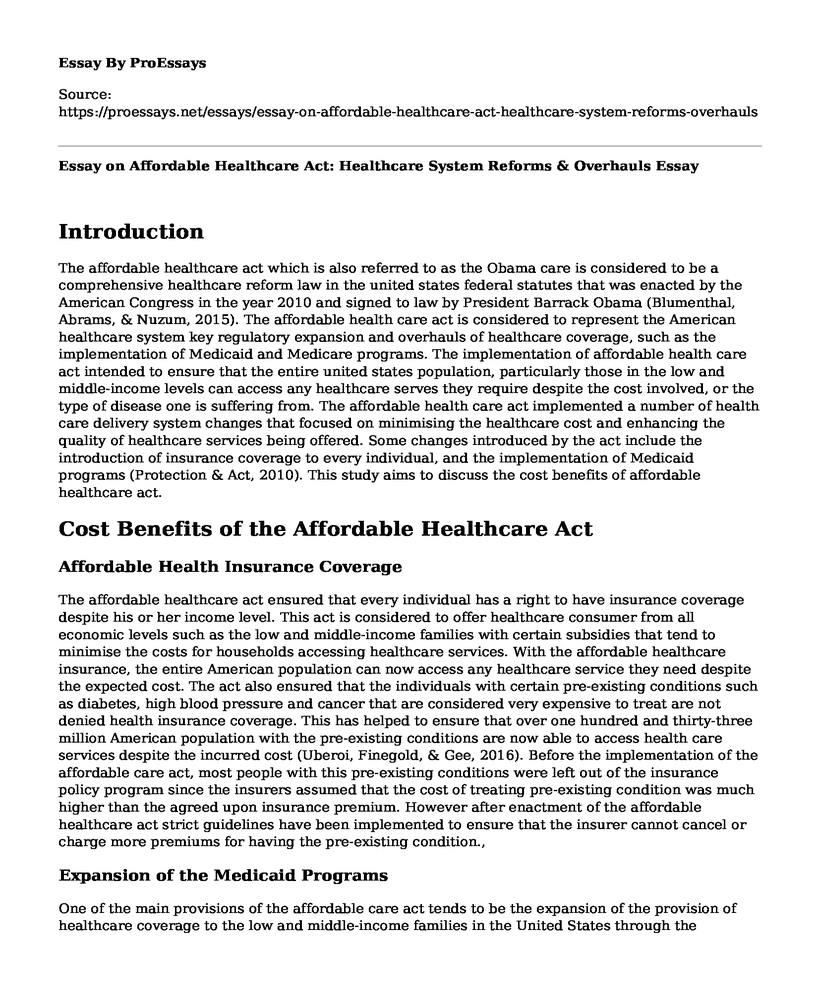Introduction
The affordable healthcare act which is also referred to as the Obama care is considered to be a comprehensive healthcare reform law in the united states federal statutes that was enacted by the American Congress in the year 2010 and signed to law by President Barrack Obama (Blumenthal, Abrams, & Nuzum, 2015). The affordable health care act is considered to represent the American healthcare system key regulatory expansion and overhauls of healthcare coverage, such as the implementation of Medicaid and Medicare programs. The implementation of affordable health care act intended to ensure that the entire united states population, particularly those in the low and middle-income levels can access any healthcare serves they require despite the cost involved, or the type of disease one is suffering from. The affordable health care act implemented a number of health care delivery system changes that focused on minimising the healthcare cost and enhancing the quality of healthcare services being offered. Some changes introduced by the act include the introduction of insurance coverage to every individual, and the implementation of Medicaid programs (Protection & Act, 2010). This study aims to discuss the cost benefits of affordable healthcare act.
Cost Benefits of the Affordable Healthcare Act
Affordable Health Insurance Coverage
The affordable healthcare act ensured that every individual has a right to have insurance coverage despite his or her income level. This act is considered to offer healthcare consumer from all economic levels such as the low and middle-income families with certain subsidies that tend to minimise the costs for households accessing healthcare services. With the affordable healthcare insurance, the entire American population can now access any healthcare service they need despite the expected cost. The act also ensured that the individuals with certain pre-existing conditions such as diabetes, high blood pressure and cancer that are considered very expensive to treat are not denied health insurance coverage. This has helped to ensure that over one hundred and thirty-three million American population with the pre-existing conditions are now able to access health care services despite the incurred cost (Uberoi, Finegold, & Gee, 2016). Before the implementation of the affordable care act, most people with this pre-existing conditions were left out of the insurance policy program since the insurers assumed that the cost of treating pre-existing condition was much higher than the agreed upon insurance premium. However after enactment of the affordable healthcare act strict guidelines have been implemented to ensure that the insurer cannot cancel or charge more premiums for having the pre-existing condition.,
Expansion of the Medicaid Programs
One of the main provisions of the affordable care act tends to be the expansion of the provision of healthcare coverage to the low and middle-income families in the United States through the Medicaid programs (Sommers, Gunja, Finegold, & Musco, 2015). Before the introduction of the act, most states could not give this healthcare coverage to adults without children despite being poor. While in other states, only parents were covered if they were in the extremely low-income bracket. However, after the introduction of the act, the states now provide the Medicaid program that offers healthcare coverage to many Americans including the eligible low-income adults, children elderly adults and the pregnant women (Kuhmerker & Hartman, 2007). Those eligible for this program do not have to pay for their health care services; instead, the cost incurred is catered for by the Medicaid program, which is funded by both the federal and states governments.
References
Blumenthal, D., Abrams, M., & Nuzum, R. (2015). The affordable care act at 5 years. Retrieved from https://www.researchgate.net/profile/Rachel_Nuzum/publication/276071131_The_Affordable_Care_Act_at_5_Years/links/59ee0fa34585154350e8004e/The-Affordable-Care-Act-at-5-Years.pdf
Kuhmerker, K., & Hartman, T. (2007). Pay-for-performance in state Medicaid programs. A Survey of State Medicaid Directors and Programs, 2007.
Protection, P., & Act, A. C. (2010). Patient protection and affordable care act. Public law, 111(48), 759-762. Retrieved from http://legcounsel.house.gov/Comps/PPAACA_BEL.pdf
Sommers, B. D., Gunja, M. Z., Finegold, K., & Musco, T. (2015). Changes in self-reported insurance coverage, access to care, and health under the Affordable Care Act. Jama, 314(4), 366-374. Retrieved from https://jamanetwork.com/journals/jama/fullarticle/2411283
Uberoi, N., Finegold, K., & Gee, E. (2016). Health insurance coverage and the Affordable Care Act, 2010-2016. Washington (DC): Department of Health and Human Services, Office of the Assistant Secretary for Planning and Evaluation. Retrieved from http://garnerhealth.com/wp-content/uploads/2014/02/ACA2010-2016.pdf
Cite this page
Essay on Affordable Healthcare Act: Healthcare System Reforms & Overhauls. (2023, Jan 29). Retrieved from https://proessays.net/essays/essay-on-affordable-healthcare-act-healthcare-system-reforms-overhauls
If you are the original author of this essay and no longer wish to have it published on the ProEssays website, please click below to request its removal:
- Steroids: Who's to Blame? Essay
- Mass Incarceration in the Land of Freedom Paper Example
- Reed Healthcare System and CHNA Paper Example
- Opioid Abuse and Addiction: Evaluating Prevention and Health Programs - Essay Sample
- Wrongful Birth: USA Legal Challenges & Child's Severe Medical Defects - Research Paper
- Essay Example on Obesity: a Serious Disease with Severe Health Risks
- Free Essay Example on Addressing Nursing Shortage: Educational Background, Expertise







